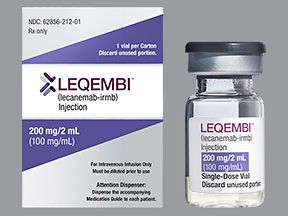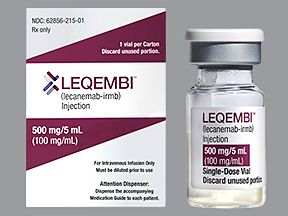Leqembi (lecanemab-irmb) is a brand-name drug prescribed for adults with Alzheimer’s disease. Leqembi comes as an intravenous infusion that’s given by a healthcare professional, typically every 2 weeks.
Leqembi is a biologic drug and belongs to a drug class called monoclonal antibodies. Leqembi isn’t available in a biosimilar version.
Keep reading for specific information about the dosage of Leqembi, including its strengths and how to take the medication. For a comprehensive look at Leqembi, see this article.
Note: This article describes typical dosages for Leqembi provided by the drug’s manufacturer. However, your doctor will prescribe the Leqembi dosage that’s right for you.
The information below describes Leqembi’s typical dosing schedule and other details about the drug.
Leqembi form
Leqembi comes as a liquid solution in single-dose vials. Your doctor or another healthcare professional will give you Leqembi as an intravenous (IV) infusion. You’ll receive your infusions at your doctor’s office, hospital, or clinic.
Leqembi strengths
Leqembi comes in one strength: 100 milligrams (mg) drug per milliliter (mL) of solution.
The single-dose vials are available in two sizes:
- 500 mg/5 mL
- 200 mg/2 mL
Typical dosages
Typically, your doctor will prescribe a dosage based on your body weight in kilograms.* Then, they may adjust your dosage, depending on how your body responds to the drug. For details, see the “Factors that can affect your dosage” section below.
The following information describes the dosage that’s commonly prescribed or recommended. However, your doctor will determine the best dosage to fit your needs.
* For reference, one kilogram (kg) is about 2.2 pounds (lb).
Dosage for Alzheimer’s disease
The recommended dosage of Leqembi for Alzheimer’s disease is 10 mg/kg of body weight once every 2 weeks.
Your doctor will check your body weight to ensure you’re receiving 10 mg/kg with each infusion.
Long-term treatment
Leqembi is meant to be used as a long-term treatment. If you and your doctor determine that Leqembi is safe and effective for you, you’ll likely continue treatment long term.
The Leqembi dosage your doctor prescribes will depend on your body weight and the results of your MRI scans.
Specifically, your doctor will monitor your scans for amyloid-related imaging abnormalities (ARIA).* This is because Leqembi treatment can cause ARIA. In fact, Leqembi has a boxed warning about the risk of ARIA. A boxed warning is the most serious warning from the Food and Drug Administration (FDA).
ARIA are certain changes in the brain, including swelling or bleeding, that are visible on an MRI scan. Your doctor will order a baseline MRI scan before you start Leqembi and more scans throughout treatment. Your doctor will recommend additional MRI scans before your fifth, seventh, and 14th infusion. (Leqembi is given by intravenous infusion.)
Dosage adjustments
If you develop ARIA, your doctor will evaluate the severity of changes. Then they’ll determine whether to pause your treatment or continue giving your Leqembi infusion as usual. The decision is usually based on whether you have symptoms† associated with ARIA as follows:
- If you develop ARIA but you don’t have symptoms, your doctor will likely continue giving your Leqembi dose.
- If you develop mild to severe ARIA symptoms, your doctor will likely pause your treatment. They’ll continue to monitor your MRI scans until your symptoms go away.
If you have questions about your Leqembi dosing schedule, talk with your doctor for more information.
* Amyloid is an atypical protein in your brain that can build up between your nerve cells.
† Symptoms due to ARIA can include headache, nausea, dizziness, changes in vision, and difficulty with balance.
Your doctor or another healthcare professional will give you Leqembi as an intravenous (IV) infusion. You’ll receive infusions at your doctor’s office or at a hospital or clinic. Typically, Leqembi infusions take about 1 hour.
Leqembi infusion premedications
Your doctor may give you certain medications before your Leqembi dose. Also known as premedications, they can help reduce your risk of certain side effects* with Leqembi infusions. These can include skin rashes, hives, or swelling. You may receive the following types of drugs:
- antihistamines such as diphenhydramine (Benadryl)
- steroids such as prednisone (Rayos)
- anti-inflammatory medications such as ibuprofen (Advil, Motrin)
* To learn about side effects of Leqembi, see this article for more information.
If you miss a scheduled appointment for your Leqembi infusion, contact your doctor’s office right away. They’ll help schedule a new appointment as soon as possible.
To help make sure that you don’t miss an appointment, try using a reminder system. This can include creating an appointment reminder on your phone calendar or putting a note where you’ll see it, such as on your bathroom mirror or bedside table. You could also download a reminder app on your phone.
The dosages in this article are typical dosages provided by the drug manufacturer. If your doctor recommends Leqembi for you, they’ll prescribe the dosage that’s right for you. If you have questions about the dosage of Leqembi that’s best for you, talk with your doctor.
Besides learning about dosage, you may want other information about Leqembi. These additional articles might be helpful:
- More about Leqembi. For information about other aspects of Leqembi, refer to this article.
- Side effects. To learn about side effects of Leqembi, see this article. You can also look at the Leqembi prescribing information.
- Cost. If you’d like to learn about Leqembi and cost, see this article.
- Details about your condition. For details about your condition, see our Alzheimer’s disease and dementia hub.
Disclaimer: Medical News Today has made every effort to make certain that all information is factually correct, comprehensive, and up to date. However, this article should not be used as a substitute for the knowledge and expertise of a licensed healthcare professional. You should always consult your doctor or another healthcare professional before taking any medication. The drug information contained herein is subject to change and is not intended to cover all possible uses, directions, precautions, warnings, drug interactions, allergic reactions, or adverse effects. The absence of warnings or other information for a given drug does not indicate that the drug or drug combination is safe, effective, or appropriate for all patients or all specific uses.


